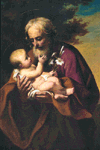 Traditional Oblates of
Traditional Oblates of  Traditional Oblates of
Traditional Oblates of
In the course of centuries, Benedictines attracted
God fearing people to associate themselves spiritually with their monasteries. These
entered into varied relations with an Abbey, either living there, or, while living in the
world, becoming intimately linked with the Abbey by lending financial support, or by
rendering voluntary services, or by promising obedience to the religious superior.
The connecting link was the spirit of the Holy Rule of St. Benedict,
which formed the bond of union, the chain of charity. And as is natural when the
same principals of conduct are followed by many, if not to the letter at least in the
spirit, an association or society was gradually formed. This in time developed into
the Institute of Secular Oblates as it now stands, a confraternity founded on the
principles which led St. Benedict to sanctity and to solid Christian virtues.
An Oblate of St. Benedict is a Catholic who, by affiliation with some monastery of the
Benedictine Order, strives to lead a more perfect life by ordering it, as far as
circumstances permit, according to the Holy Rule of the great Patriarch of western
monasticism. The Church has given approval to such a union, and in a certain sense
considers the Oblate as a member of the monastic family, sharing in its good works and
receiving from it a valuable impulse and aid to a more perfect life. Because of its
spirit of discretion and great flexibility with regard to the spiritual needs of the
faithful Christian, both in his private and social life, the Holy Rule of St. Benedict can well
serve as a guide, not only for monks and nuns, but also for the faithful living in the
world.
The word Oblate is derived from the Latin word
"oblatus," which means something offered - an oblation to God. An Oblate
must therefore be a pleasing victim upon the altar of Christian self-denial and
mortification. This practice of self-denial will consist largely in the correction
of faults and the improvement of morals, in order that they may become the more pleasing
to God.
As each Benedictine Abbey is independent, each Abbey aggregates its own Oblate members, who are spiritually connected with one another. Oblates may well remember what the great John Mabillon said when visiting the grotto of Subiaco in 1687: "This is the rock from which we are hewn" (Isaias 11.1). The Nursian youth had left Rome, "the mistress of the world," to hide himself in the grotto of Subiaco. From the rock he could look down on the "lake" in which formerly the elegant summer-houses of Nero were reflected. The glory of the world is gone, but the rock remains and with it has survived the history of the noble struggle of St. Benedict. The weapon with which he conquered were the two contained in the time honored motto: "Pray and work," - the Benedictine ideal.
(Excerpted from Daily Companion for Secular Oblates of St. Benedict, 2nd. Edition, February 1948)
[HOME]
[OBLATES] [RULES] [DUTIES] [PRAYERS] [ORA] [LABORA] [SAINTS] [FAVORS] [REMARKS]
[ST. BENEDICT] [MEDAL] [INDULGENCES] [PURGATORY PRAYERS]
[HOLY WATER] [EXORCISM] [WEBSITES]
[VISITS TO THE BLESSED SACRAMENT]
[LITANIES]